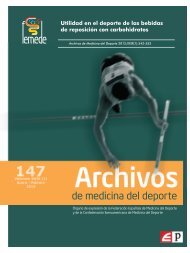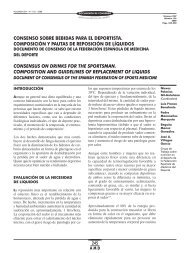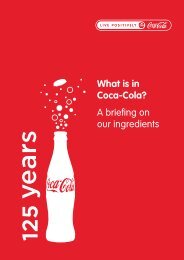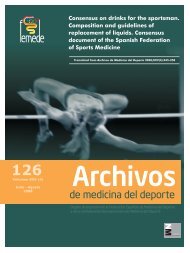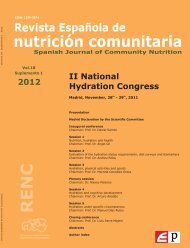athletes' medical information - Coca-Cola
athletes' medical information - Coca-Cola
athletes' medical information - Coca-Cola
Create successful ePaper yourself
Turn your PDF publications into a flip-book with our unique Google optimized e-Paper software.
athletes’ <strong>medical</strong> <strong>information</strong><br />
usually discussed in terms of an athlete’s Fat<br />
Free Mass (FFM) – i.e., body mass minus body<br />
fat. This threshold is set at 30 kcal (125 kJ) per<br />
kg FFM.<br />
There are three situations that are typically<br />
associated with low energy availability:<br />
Disordered eating and eating disorders. We<br />
used to think this was the main cause of<br />
energy deficiencies, causing some stigma to<br />
the situation. Disordered eating requires early<br />
intervention and specialist help, but we now<br />
know that many athletes can get into<br />
situations of low energy availability without<br />
this backdrop.<br />
Restricted eating for weight control or loss or<br />
body fat. Many athletes undertake such<br />
campaigns with the best of intentions and,<br />
often, good reasons. However, the degree of<br />
energy deficit achieved by reduced energy<br />
intake or increased exercise may be too<br />
severe for good health. Even when weight<br />
loss is undertaken without any problem<br />
behaviour or undue stress, trying to achieve it<br />
at too fast a rate is likely to lead to<br />
unnecessary compromises of health<br />
and performance.<br />
Inadvertent failure to increase energy intake<br />
sufficiently during periods of high-volume<br />
training or competition. Some athletes<br />
undertake extremely strenuous training or<br />
competition programs. Appetite, time for<br />
preparing and eating food, and awareness of<br />
intake are just some of the factors influencing<br />
our food intake that may not always keep<br />
pace, especially when there is a sudden<br />
increase in exercise load. The practicality of<br />
eating a high energy intake day after day can<br />
be challenging for many athletes. Some may<br />
be unaware that they are falling behind in<br />
meeting their energy needs, or that it is<br />
problematic. This is especially the case in<br />
Paralympic athletes who have undertaken a<br />
period of time in rehabilitation where the<br />
focus has been on prevention of body fat gain,<br />
and/or who are relatively new to elite sport.<br />
12-113-COC_Paralymics_Booklet_20120718.indd 7<br />
7/18/12 4:29 PM






